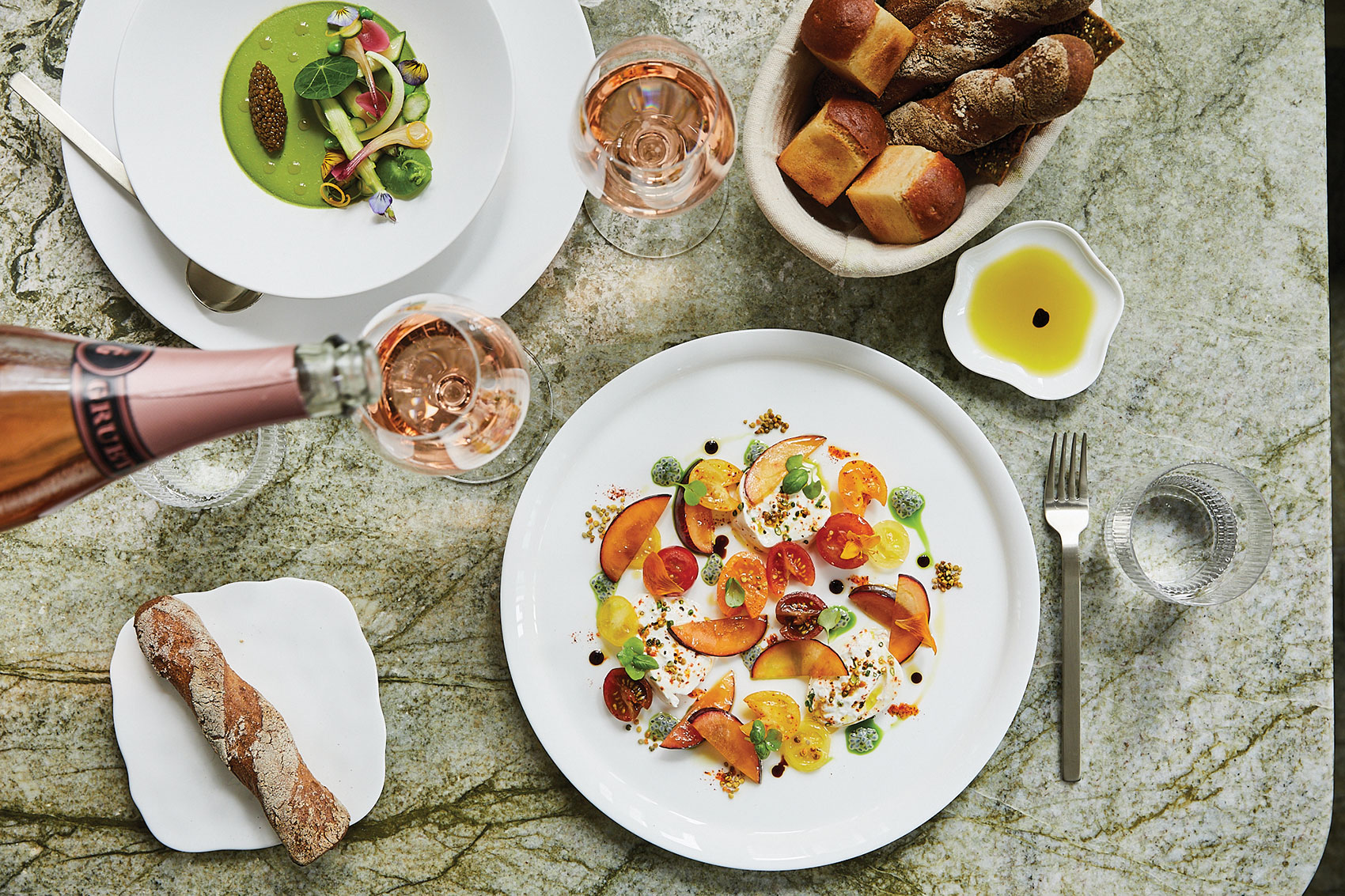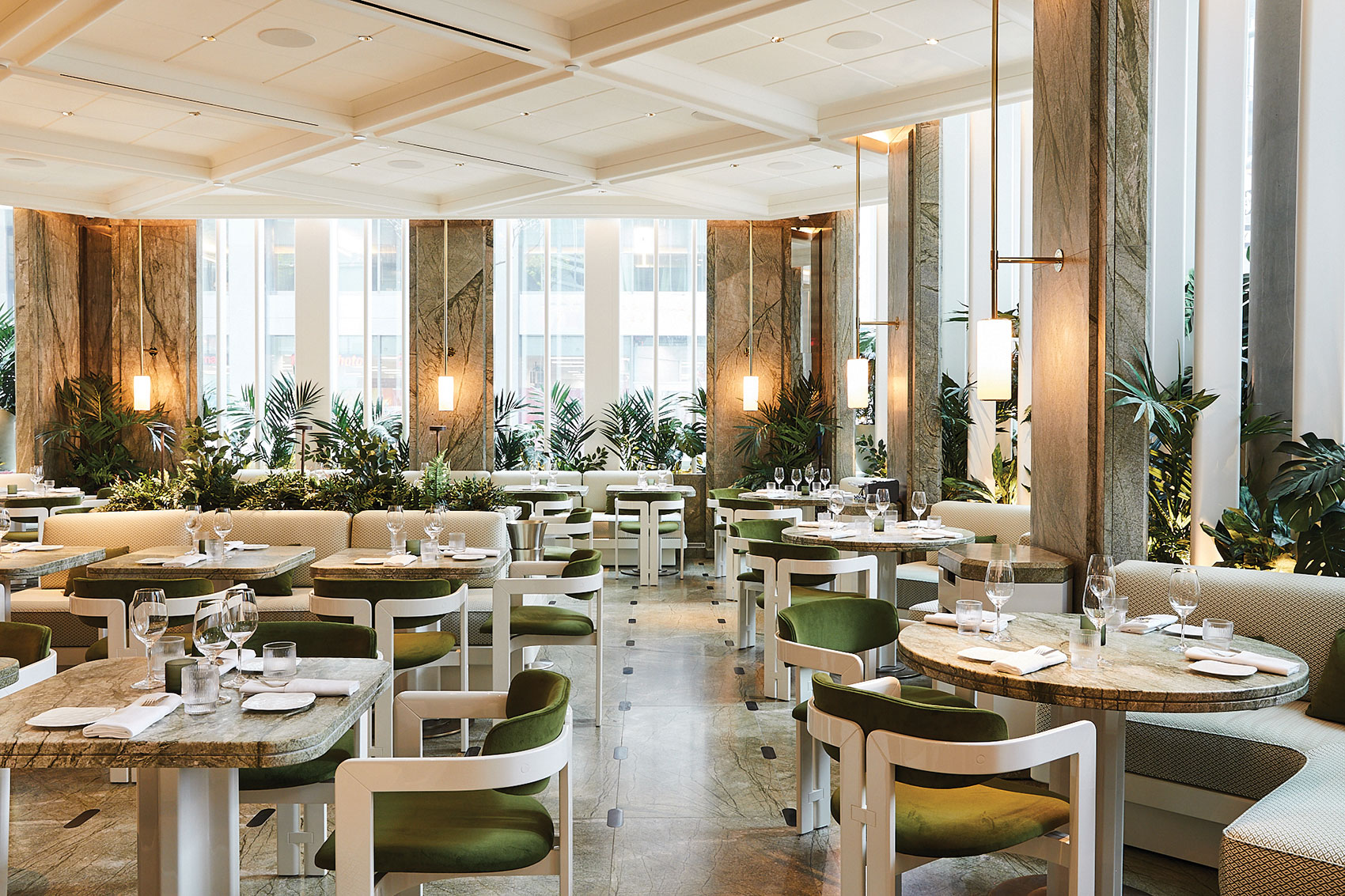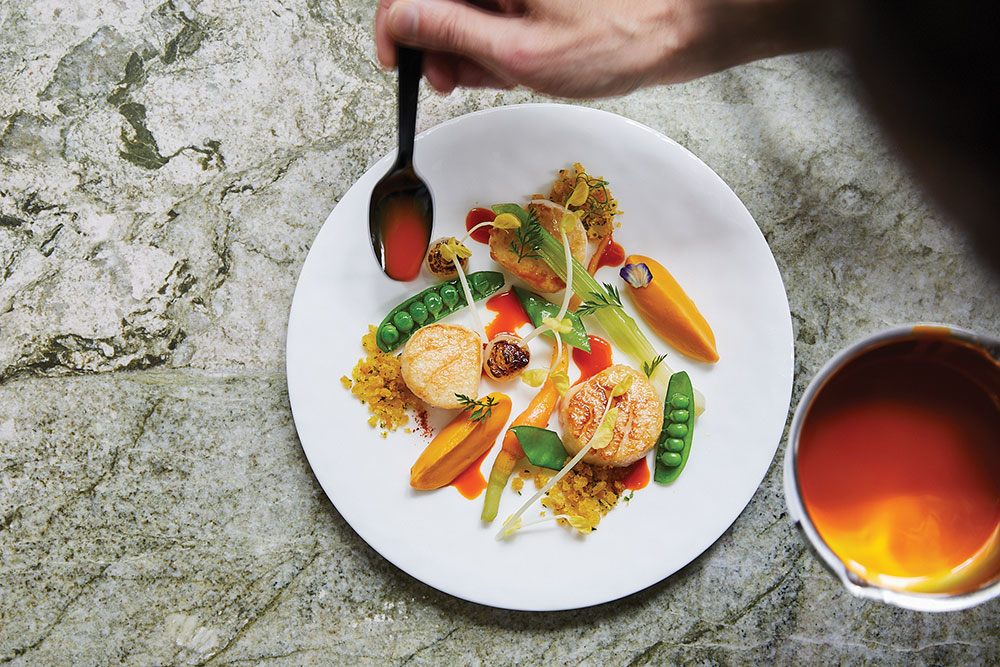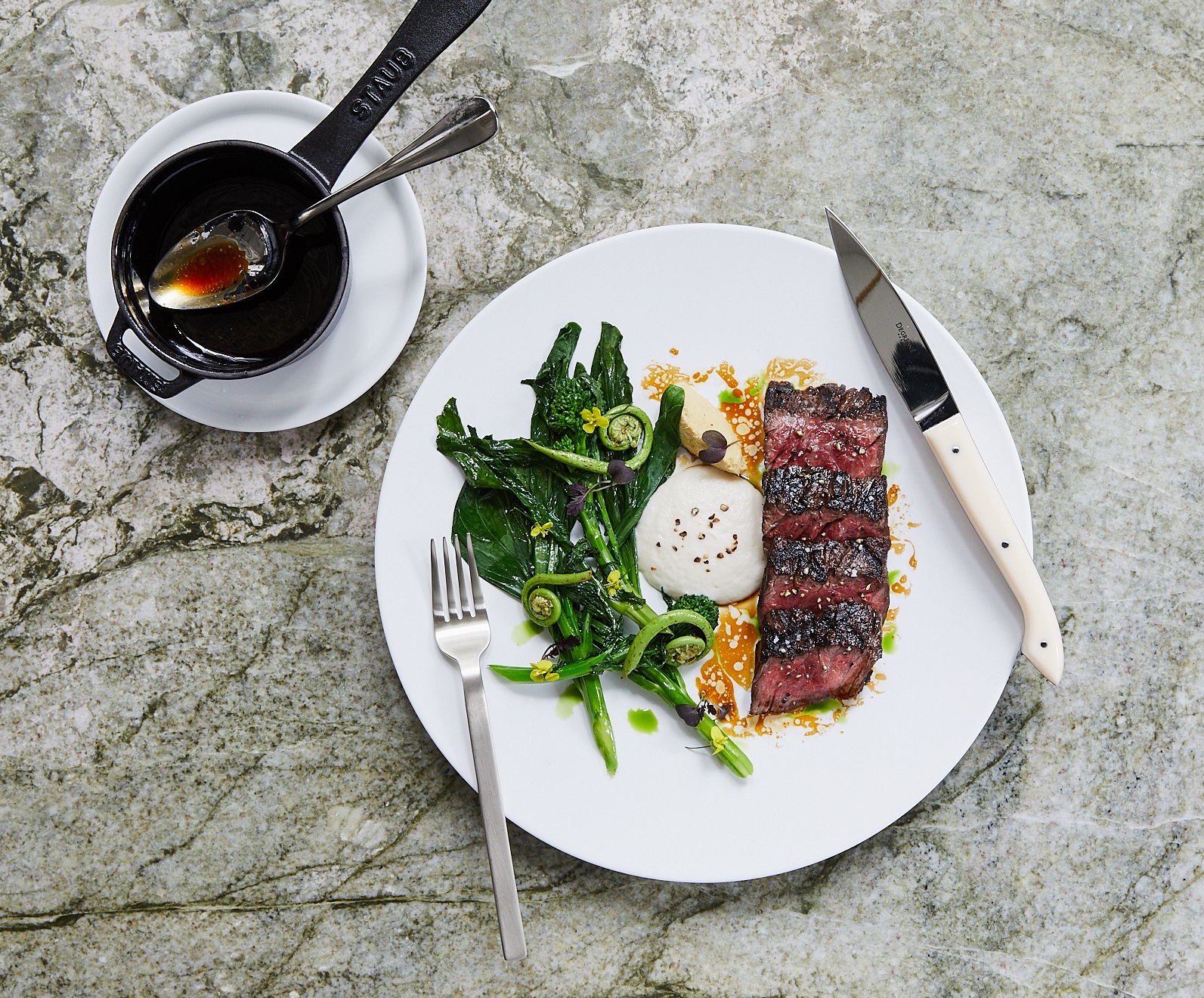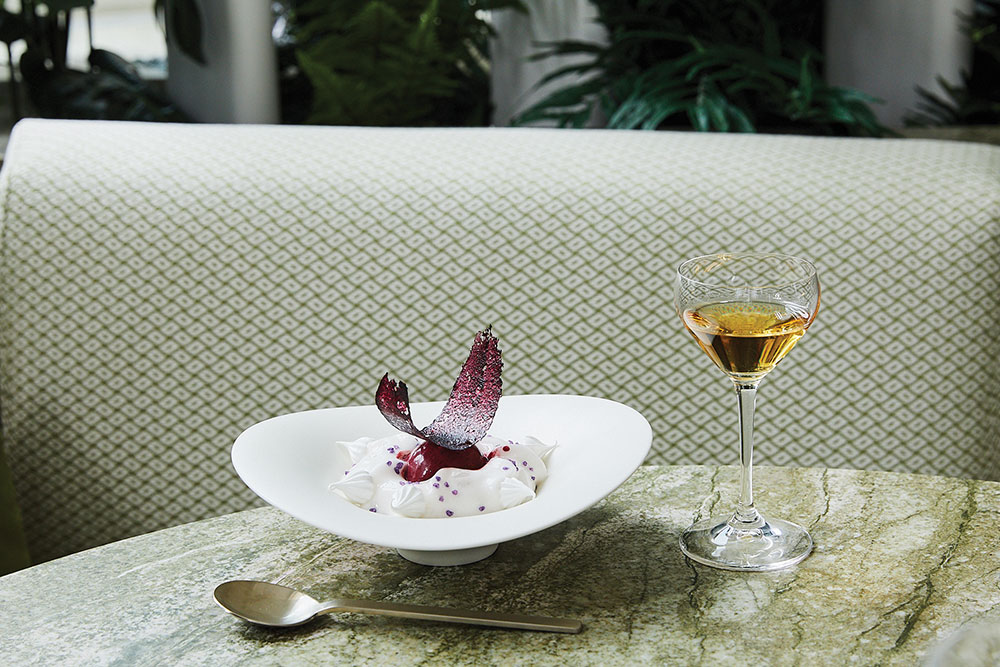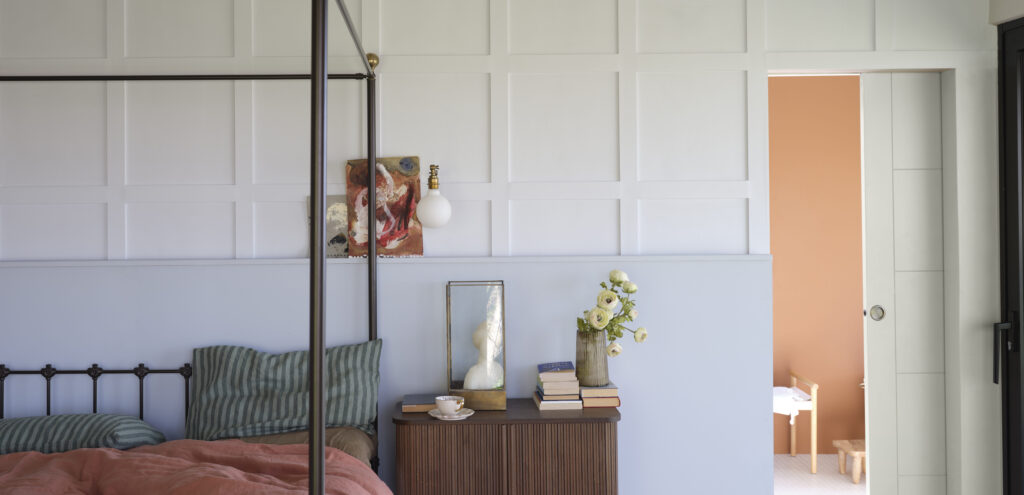At Le Jardinier in Midtown, a terrarium appears at the table. Except, there aren’t any spiny succulents inside. A scoop of olive oil ice cream floats atop a pool of pink strawberry mousse, dotted with edible flowers and crushed basil granité. It’s almost too pretty to eat, and yet I dig in.
Everything about Le Jardinier calls for your imagination. From the intense artistry behind their plating, the “upscalification” of humble ingredients to transporting guests like myself from the gray streets of New York City to a green-hued, light-filled culinary oasis. Summer squash shows up as whimsy spirals next to rosettes of Montauk fluke. Almonds and chanterelle mushrooms conceal a zucchini half with bright orange romesco sauce setting the plate ablaze. It is an enchanting display of nature, but its significance speaks to our changing culinary climate.
Today’s headlines will tell you that eating more vegetables and less meat is not only better for our health, but it’s also the most sustainable option looking towards the future. Chefs like Dan Barber of Blue Hill at Stone Barns or Alain Passard have made careers out of elevating the vegetable, and I myself have I’ve bared witness to this subtle shift in restaurants across the tri-state whose mission it is to make vegetables more desirable.
Before opening Le Jardinier, Michelin-starred Chef Alain Verzeroli acted as protégé for 21 years to the late, famed French chef Joël Robuchon. Robuchon was a man whose own culinary ethos was to make the simplest ingredients exciting, turning dishes such as mashed potatoes or “pommes purée” into an art form. Most recently, Chef Verzeroli was the Director of Culinary Operations at Château Restaurant Joël Robuchon in Japan—a country that would later hold significance in the lives of both men and inspire the hyperseasonal culinary aspirations behind Chef Verzeroli’s newly-opened restaurant, Le Jardinier.
The restaurant’s interior, designed by award-winning Parisian architect Joseph Dirand, takes cues from Chef Verzeroli’s vegetable-forward vision with an abundance of plant life and floor-to-ceiling windows to mimic the workings of a greenhouse. Nearly everything from the marble walls to the floors, tables and chair cushions are brushed with a mossy hue.
“By definition, Le Jardinier means ‘the gardener,’ or the one who’s tending the garden—the crop you yield is a direct result of the care and love you’ve given it,” Chef Verzeroli explained. “We use the same level of care and attention to select, transform and serve the ingredients to our guests.” The menu he’s created is a culmination of those very sentiments, plus philosophies passed down by Robuchon and principles of Japanese cooking where dishes are often built around seasonality and extract the very essence of an ingredient.
This is essentially where Chef Verzeroli sees us heading in the future, having already observed restaurant-goers from across the globe taking a more flexitarian approach. The movement gaining traction right now is one where locally-sourced fruits, vegetables and herbs take the lead on plates over fish, meat and poultry. I’ve seen enough cauliflower steaks and plant-based burgers to know this to be true, but it takes some convincing to make today’s Midtown diners buy into “health food” as haute.
“The menu and concept for Le Jardinier was inspired by the way I like to eat these days; vegetable-based, but not fully vegetarian,” Chef Verzeroli said. “I love to feel the sense of nature and the seasons on my plate, and put as much care into the treatment of the vegetables as the proteins.”
A dinner at Le Jardinier starts off with an amuse-bouche, or what I jokingly referred to as an amuse-juice—a concentrated shot of a beet, carrot, apple and ginger. An enticing bread basket makes its way to the table where the usual suspects appear with a gluten-free twist. Parker House rolls are made with Japanese rice flour; French-style baguettes made from a blend of buckwheat, teff and sorghum; and crisp shards of lavash are sprinkled with sesame seeds, poppy seeds, quinoa, matcha powder and Japanese shichimi pepper. The bread program, thought up by master baker and fellow Robuchon alum Tetsuya Yamaguchi, is a testament to Le Jardinier’s willingness to adapt to dietary sensitivities—albeit with the same level of quality and taste.
More than half of Le Jardinier’s menu is completely void of meat or poultry. Although admittedly, that’s not what I came for. The dishes, I found, are sized appropriately for sharing, if you desire, and highlight the best of a single in-season ingredient with supporting characters that emphasize texture, color and flavor. Think thinly shaved slices of melon with dollops of creamy burrata, sweet figs and marcona almonds; fresh watermelon with heirloom tomatoes, ginger and mint; and earthy baby carrots with snap peas, spring onions and seared Maine scallops.
Starches are limited on the menu but include either a risotto made from pearled farro with artichokes, romano beans and smoked paprika or fingerling gnocchi topped with a tomato coulis, parmesan cheese and charred corn. The heartier (meat-inclusive) entrées range from signature dishes like their tender Bavette au jus served with turnip puree, sautéed broccolini and horseradish or the heritage chicken with sweet corn and black currants. A seasonal standout during my late-July visit was the Dover Sole which was served over a buttery, but delicate, lemongrass foam with fresh summer vegetables scattered over top.
The desserts at Le Jardinier are nothing short of head-turning (I mean that literally), executed to perfection by Pastry Chef Salvatore Martone—a third Robuchon alum. Similar to the restaurant’s savory offerings, each of the desserts are in perfect harmony balancing bitter, acidic, salty and sweet flavors, while centering around one main ingredient. Their presentations are ambitious—not to forget the aforementioned “terrarium”—and are as wonderful to eat as they are interesting to look at. Take the lemon meringue tart, for example, which exudes the very essence of the fruit with complements of a citrus marmalade. The blueberry and lemongrass duo is simply a dish of contrast with a sorbet made from fresh blueberries and tangy coconut yogurt, fluffy lemongrass foam and crispy vegan meringues. Catering to the dairy-intolerant are a variety of plant-based ice creams with flavors including chocolate with rice milk; pistachio and cashew milk; and coffee with rice milk.
In terms of what Chef Verzeroli has on the horizon, he didn’t waste any time before opening his second New York City restaurant just one month after Le Jardinier. Shun (pronounced “shoon”) is named after the Japanese culinary tradition that celebrates seasonal food at its peak flavor. While the two restaurants share similarities surrounding seasonal cooking—and occupy space in the same luxury high-rise—Shun is grounded in French technique while utilizing traditional Japanese ingredients.
“All of the experience and knowledge I gained working with Chef Robuchon serves as the foundation of my cooking. However, with the opening of Le Jardinier and Shun, I’m able to develop my own culinary voice, and explore my personal creativity as a chef,” he explained. Through his most recent ventures, Chef Verzeroli hopes to introduce tri-state area diners to a fresh take on fine dining, one that he believes emphasizes the luxury in simplicity.

